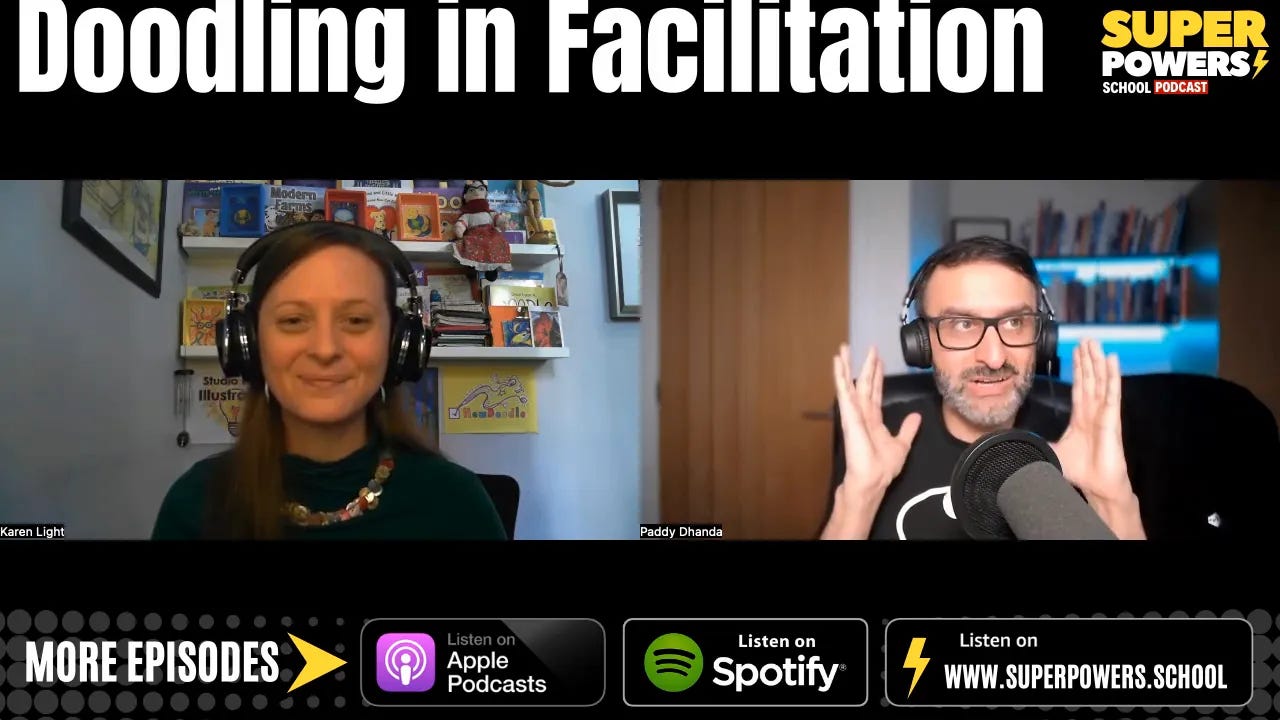In today’s episode, I explored the art of doodling in facilitation with artist and creative coach
on the Superpowers School podcast. One question I put to Karen was:“Surely people who doodle in meetings aren’t paying attention?”
She laughed.
Then she responded with:
“Doodling actually helps you retain more information. It engages three learning centers at once—visual, auditory, and kinesthetic. It’s like a brain hack.”
It turns out the scribbling in your notebook isn’t a distraction after all. It amplifies focus.
And yet, most workplaces frown upon doodling and see it as unprofessional. Something people do when they’re zoning out. A bad habit.
But what if we’ve been thinking about it all wrong?
Why Doodling Works (Backed by Science)
We assume that “paying attention” means sitting still, staring intently, and nodding at the right moments.
But the brain doesn’t work like that.
In one study, psychologist Jackie Andrade found that people who doodled while listening to a monotonous voicemail remembered 29% more information than those who didn’t.
Why? Because doodling prevents your brain from drifting into daydream mode. Instead of completely zoning out, your brain stays engaged in a low-level cognitive activity—just enough to help you focus without becoming overwhelmed.
Visual thinking expert
, author of The Doodle Revolution, calls this“taking notes with your subconscious.”
So if you’ve ever been in a meeting where your mind wandered after five minutes, it wasn’t because you’re not paying attention. It’s probably because you weren’t doodling.
How to Use Doodling to Supercharge Meetings
Doodling isn’t about making art—it’s about making connections.
If you’re a facilitator, leader, or product professional, here’s how you can introduce doodling into your meetings (without scaring anyone away):
1. The One-Minute Doodle Check-In
Instead of the usual “How’s everyone feeling?” icebreaker, try this:
Give each person 60 seconds to draw how they feel—using only shapes, symbols, or stick figures.
Ask for volunteers to share their doodles.
Use it as a conversation starter.
This works because people process emotions visually before they can articulate them in words.
2. Sketch Your Notes (Instead of Writing Them)
Encourage your team to replace bullet points with sketches:
Instead of writing “Q2 strategy,” draw a rocket taking off.
Instead of “customer churn problems,” sketch a leaky bucket.
Use arrows, boxes, and stick figures to map out ideas visually.
It doesn’t have to be pretty—it just has to make sense to you.
3. The Live Whiteboard Doodle
During brainstorming sessions, designate a “Doodle Zone” where anyone can sketch ideas:
On a physical whiteboard
On a Miro/MURAL board for remote teams
On sticky notes arranged in clusters
Visual notes make it easier for people to recall ideas later—because our brains store images more effectively than words.
Live Experiment: Try This Right Now
Karen had me do this exercise on the podcast, and it was surprisingly insightful.
Give it a shot:
Grab a piece of paper and a pen.
Draw a continuous spiralling line in the centre of the page.
Let your hand wander naturally. No pressure. No perfection.
Look at what you’ve drawn. Does it remind you of anything?
I did this and somehow ended up drawing something that looked like an ear.
Karen asked me:
“What do you hear with your inner ear? What do you need to voice more in your work?”
It was a real ah-ha moment that created instant self-reflection.
This is why doodling isn’t just a creativity tool—it’s a thinking tool.
Doodling for Emotional Intelligence
Karen shared how doodling helped her through a major career transition.
She felt stuck—so she started carrying a tiny notebook, filling it with random sketches every day.
At first, the drawings didn’t mean anything.
But after a few weeks, patterns started emerging.
She was able to see her emotions on paper before she could verbalise them.
This is why doodling can be a powerful tool for processing stress, making decisions, and even navigating career changes.
As Karen put it:
“Doodling lets you express things you don’t have words for.”
Final Thoughts: Give Your Team Permission to Doodle
Doodling isn’t just for kids or artists. It’s for anyone who wants to think more clearly, retain more information, and unlock creativity.
It helps you:
✅ Stay focused in meetings
✅ Process complex ideas faster
✅ Remember more information
✅ Reduce stress and mental overload
So next time you see someone doodling during a meeting, don’t assume they’re zoning out.
They might actually be the most engaged person in the room.
Try it for yourself.
And if someone asks, “Are you even paying attention?”—just tell them:
“I’m activating multiple neural pathways for optimised cognitive performance.”
Wow, that’s something smart people would say. A huge thank you to
for the inspiration behind this article.Further Reading & Resources
📖 The Doodle Revolution by Sunni Brown
🖋️ Scribble Therapy by Karen Light (Check out her Substack!)
🧠 The Back of the Napkin by Dan Roam
Let’s get people engaged, thinking differently, and making their meetings more fun—one doodle at a time.
For more insights on enhancing your facilitation skills, check out Authenticity for Effective Facilitation and Creative Questions to Facilitate Deeper Connections in Workshops.
Guest: Karen Light
Karen Light is a multi-passionate Creative, Artist, and Neurodiversity Advocate dedicated to helping others activate their creativity and embrace their unique minds. As the founder of Studio Light Illustration, she illustrates books for self-publishing authors and creates meaningful, mixed-media art. She also runs HowDoodle, a Creative Productivity Coaching company supporting neurodiverse individuals in harnessing their strengths. With a background in art, education, and executive function coaching, Karen empowers both creatives and non-creatives to unlock their potential. She holds a BFA (Xavier University), an MA in Cultural Management (City University London), and coaching certifications from Transformation Academy and the Academy of Modern Applied Psychology.













